Unifix cubes can be a great way of adding a more visual and hands-on learning component to math lessons.
Having something to touch and feel can be a great way to help students get their heads around complicated math concepts, and the simple nature of these linking cubes often belies their flexibility and usefulness in a lesson.
If you’re new to homeschooling, or just want more information on how these little cubes can help your student better understand their math lessons, then read on as we examine Unifix cubes and their use in learning.
What Is A Unifix Cube
Invented by Charles Tacey in 1953 in the UK, Unifix cubes were designed as a way to replace the traditional counting beads used in the classroom with a shape that wouldn’t roll off a student’s desk and get lost quite so easily.
In essence, Unifix cubes are little plastic, smooth-sided cubes with a single “stud” or connector on top and a hole on their bottom that allow them to be vertically linked together and taken apart quickly and easily.

How Do Unifix Cubes Help Students?
Like other linking counting cubes, Unifix cubes are commonly used in math classes and curricula around the world as a manipulative, a tactile object or instructional device that makes math learning more hands-on.
Teachers and homeschooling parents, for example, can use them to model a variety of math concepts across a number of areas.
Beyond giving students a more tactile and multisensory learning experience during their lessons, Unifix cubes and other linking cubes can make math a little more understandable and approachable, particularly for younger students.
Until the age of 12 or so, most children tend to think concretely.
While their logical reasoning might be pretty sharp, they tend to understand the world in terms of what they can directly observe, in particular what they can see, touch and hear.
As a result, math equations and symbols, which distill more complex ideas and concepts into simple, compact and elegant expressions, can be hard for younger students to get their minds around and fully understand.
Manipulatives like Unifix cubes give students something they can see, hold and work with as they learn.
In this way, the sometimes confusing and abstract concepts in math, such as place value or fractions, can be brought to life with cube models and be made more intuitive and understandable as a result.
Traditionally, Unifix cubes and other linking manipulatives have been used in classrooms to model relatively simple concepts such as patterns, 1:1 correspondence, adding and subtracting.
Over the years, however, they have been put to more extensive use in math curricula (both homeschool and traditional), being used to explore concepts such as:
- Place value
- Multiplication
- Division
- Fractions and their operations
- Regrouping
- Perimeter
- Area
- Volume
- Mathematical reasoning and logic
- Modeling word problems
- Beginning algebraic expressions
How Do Unifix Cubes Compare To Other Popular Counting Cubes
Unifix cubes are a kind of linking counting cube and share a few similarities with rival products as well as a few differences.
Similarities
They are, for example, made of relatively soft plastic and have round edges, to make them safer for small hands and eyes (and a little safer parent’s feet at night).
They come in a variety of colors, 10 to be precise, which can be used to help represent different numbers, ratios, fractions and so on.
They are also of a similar size and weight to other counting cubes, being about ¾ of an inch in terms of length, width and height, and can be snapped together and taken apart due to a projecting connector on their tops and indentation on their bottoms.
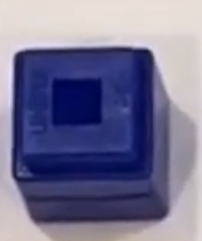
Finally, they are quite affordable and parents can buy quite a few online for their kids for very little money. Parents can, for instance, purchase 1000 individual cubes for under $100, or about 10 cents a cube.
Differences
With that said, Unifix cubes are a bit different than other counting cubes options out there, such as Snap Cubes or MathLinks.
Most notably, they have flat sides and only a single connector.
This means that they can really only be connected together in a straight line, which limits users from expanding a model outwards from its sides.
While there are “corner cubes” for Unifix, which allow users to connect them at right angles, by and large most Unifix cubes will link up and down.
While this does make them more unidimensional than some other offerings out there, it can also be a good thing for some students.
While they may not be able to as easily make fancy 3D objects with their cubes, Unifix cubes can keep them more focused on the math aspect of learning and less so on free building.
Another notable difference is that many users state that Unifix cubes pull apart a little easier than many of its rivals, likely due to the large connector and expanded indentation or hole on the bottom, which makes them a little easier for younger kids and those with fine motor difficulties to use.
Finally, Unifix cubes are distributed in the US by Didax, Inc., who also offer a vareity of interesting Unifix-related accessories and block-style products that parents can consider, such as:
- Larger, “Jumbo Unifix Cubes,” which can be good for very young students and those with more severe motor challenges
- Various bases, magnetic charts, cube holders and more to go with different lessons and concepts
- Corner cubes, for making 90 degree turns
- Letter and reading cubes, for language arts integrations and work
The company even offers virtual Unifix cubes, which can allow teachers and homeschooling families to make use of the manipulatives on a digital device, rather than having to buy, store and organize actual physical cubes.
Are Unifix Cubes Compatible With Other Cubes
Unfortunately, many linking cubes have slightly different connecting studs and indentations and so don’t always fit together all that well (or at all).
Unifix Cubes’ connectors are about 0.59 inches (1.5cm) across and around 0.16 inches (0.4cm) high and will only really fit properly into an accommodating hole or indentation of that size.
Rival MathLink’s connectors, for example, are slightly shorter (0.08 inches/0.2cm), and so their receivers are a bit too shallow.
Ultimately, then, we don’t really recommend mixing and matching linking cubes all that much, especially as they can be pretty inexpensive to buy.
Ideas for Using Unifix Cubes In A Math Program
Commutative property of operations
In math, the commutative property states that, in addition and multiplication, the order of the numbers in an operation doesn’t really have an effect on their sum or product.
In other words, it doesn’t really matter what order a student adds or multiplies numbers by, the end result will be the same.
This can be very easily demonstrated using Unifix cubes with different colors.
When adding and multiplying cubes, the specific number represented by each color won’t really matter when it comes to the end result, as seen in the example below.

Hands-on graphing of data
Teaching students graphing can be a great way to help them learn to sort, organize and classify data, as well as helping them learn concepts such as 1:1 correspondence and practice their counting.
Unifix cubes come in a variety of colors and lend themselves naturally to representing different data sets.
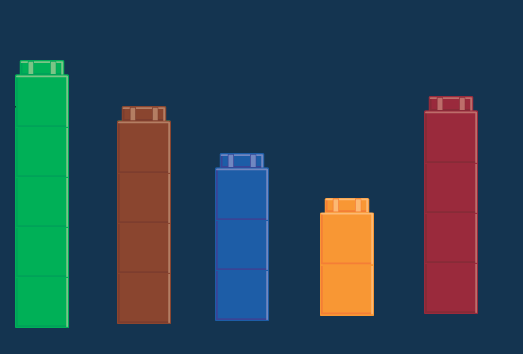
For example, they can be used to create simple bar graphs (either vertical or horizontal), as well as histograms, pictographs and even dot charts in a pinch (as long as you don’t mind your dots being cubes).
More advanced operations (multiplication and division)
Unifix cubes are most commonly used to give students something real and hands-on to work with as they learn to add and subtract.
Doing so is pretty straightforward, with students connecting or disconnecting different numbers of cubes into/from a set.
Yet, Unifix cubes can also be used to model more advanced operations, such as basic multiplication and division.
With multiplication, parents simply need to remember that Unifix cubes can be linked into arrays, i.e. rows and columns that match a multiplication equation, such as in the example below.

The cubes can also be used to model division for students.
In a simple division exercise, students can take a large stick of cubes (representing the dividend) and divide it neatly into a number of rows or columns by some divisor to get an answer.
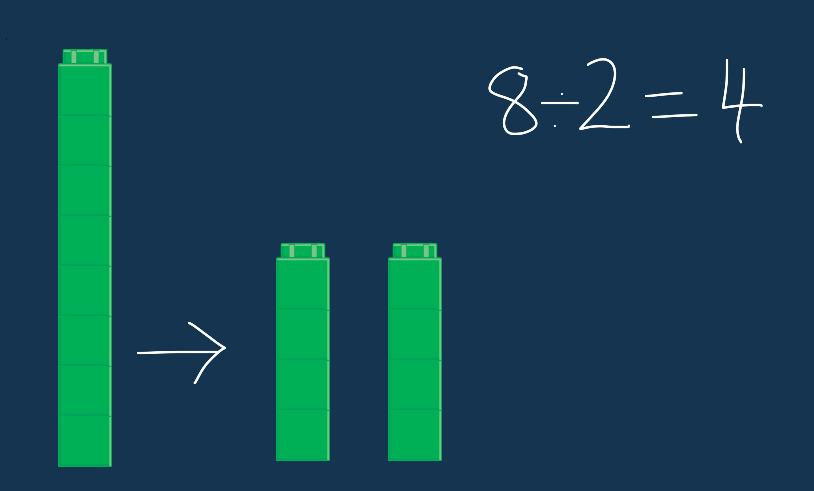
They can even intuitively represent more advanced division exercises, such as those with remainders, as one or more cubes will naturally be left on the side, unable to be formed into columns or rows that are similar to the others.
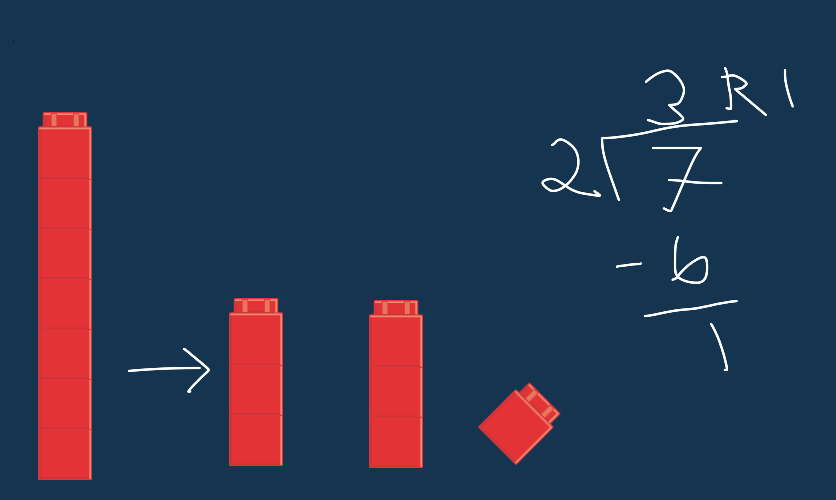
Fractions
Finally, the multi-colored Unifix cubes can be a great and intuitive way of explaining the concept of fractions to a student, with one color representing the numerator and the other the denominator.
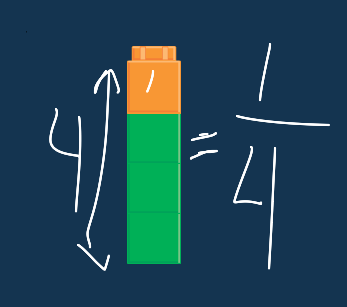
With a little more explanation and practice, they can even be worked into adding and subtracting with fractions, with students using the different colors as a more intuitive way of adjusting the numerators and denominators accordingly.

Additional Resources to Look At
Free Virtual Unifix Cubes
Didax, the distributor of Unifix cubes, has created a free program that allows parents, teachers and students to use digital Unifix cubes alongside some basic writing tools in their lessons.
While not exactly a replacement for the tactile learning qualities of actual cubes, being essentially a 2D representation of blocks, the program is colorful and pretty responsive.
It also makes hands-on math learning a lot more mobile, being able to be used on pretty much any internet-connected device with a browser, and means that parents don’t have to store and manage physical cubes.
Check out Didax’s virtual Unifix cubes app
Math curricula that make extensive use of linking cubes
If the thought of using Unifix cubes in your math lessons sounds appealing, there are quite a few math curricula out there that integrate their use pretty extensively in their lessons.
Singapore Method-based programs
There are several curricula out there that are based on the transformative Singapore method for teaching elementary math (K-6 or 8), a concepts-based mastery approach to teaching that emphasizes a gradual shift to abstract math equations from manipulatives/concrete and visual representations.
These programs often make use of linking cubes in various activities to help students explore concepts deeply and the more straightforward, math-focused Unifix cubes tend to be a good fit for the program.
There is, for example, the well-known Singapore Math company, which produces its own curricula (Dimensions) for K-8 and distributes the similarly well-known and respected Primary Mathematics program in the US for K-6 students.
There is also Math in Focus, produced by Houghton Mifflin Harcourt, which follows a similar approach with a different look and feel
RightStart Math
RightStart Math is a K-8 math program with a strong hands-on learning component and a distinctly Montessouri-inspired teaching style.
The program typically introduces concepts using a variety of hands-on activities that make use of an abacus, tiles and, yes, linking blocks to explore math concepts, and Unifix cubes can integrate nicely (and affordably) into the lessons.
Math U See
Math U See is a full K-12 math program that makes use of manipulatives for far longer into a student’s math studies than most other math courses out there, well into Algebra 1 in fact, which makes it an ideal program for families looking for a more intuitive and down-to-earth approach to math learning.
Although the company produces its own specialized cubes to be used in lessons, it’s not uncommon for homeschools on a tight budget to adapt the program to use Unifix blocks.
Where To Buy Unifix Cubes and Price
Note: Prices correct as of writing. All prices in USD.
Unifix cubes are pretty popular items and can be purchased online fairly easily.
Those looking to teach a single student should probably start off with a pack of 100 (10 tens of different colors), which can usually be picked up for less than $20.
Check out the latest price for a 100 pack on Amazon
Those teaching more than one student may want to look at larger packs, such as a set of 1000, which usually cost a little under $100
Check out the latest price for a 1000 pack on Amazon
Finally, those teaching things like place value or written form numbers may want to check out some more specialized Unifix cubes, such as those with specific numbers and values printed on their side.
Check out the latest price for place value Unifix cubes on Amazon
Bottom Line
Unifix cubes are a type of straightforward and affordable plastic linking cube that can be integrated into math lessons to add a welcome hands-on learning component.
They can be used in a number of different ways to help students get a better grasp of abstract math concepts that may otherwise confuse them and tend to integrate well into a number of conceptual homeschool math curricula.

About the Author
David Belenky is a freelance writer, former science and math tutor and a tech enthusiast. When he’s not writing about educational tech, he likes to chill out with his family and dog at home.
